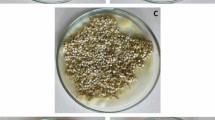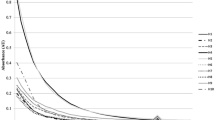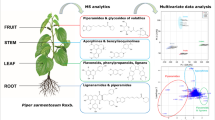Abstract
Glucosinolates (GSL) present in cultivated and feral accessions of mashua (Tropaeolum tuberosum í & Pavón) were identified and quantfied by High Performance Liquid Chromatography (HPLC) analysis. The nwin glucosinolates detected were aromatic: 4—Hydroxybenzyl GSL (OHB, Glucosinalbin), Benzyl GSL (B, Glucotropaeolin), and m—Methoxybenzyl GSL (MOB, Glucolimnathin). The total amount of GSL observed ranged from 0.27 to 50.74 micromols per gram (µMol/g) of dried tuber tissue. Most of the low-content GSL accessions are distributed within the cultivated population with a total GSL concentration lower than 5.00 µMol/g of dried tuber tissue. The highest total and specific GSL (OHB, B, and MOB) contents (more than 25.00 µMol/g of dried tuber tissue) were observed in the feral population with few exceptions. in addition, only six different GSL profiles were found: Only MOB; only B; OHB and B; OHB and MOB; B and MOB; and OHB, B and MOB.
Abstract
Se identifico y cuantificó mediante “High Performance Liquid Chromatograph” los glucosinolatos (GSL) presentes en mashua cultivada (Tropaeolum tuberosum Ruíz & Pavón) y sus parientes silvestres. Los compuestos principales descubiertos fueron los siguentes glucosinolatos aromáticos: 4—Hydroxybenzyl GSL (OHB, Glucosinalbin), Benzyl GSL (B, Glucotropaeolin) y m—Methoxybenzyl GSL (MOB, Glucolimnathin). El contenido total de GSLfluctuó entre 0.27 a 50.74 µMol/g de tejido del tubérculo seco. La mayorIa de las accesiones con bajo contenido de GSL estuvieron distribuidos dentro de la población cultivada con una concentración total de GSL menor a 5.00 µMol/g de tejido del tubérculo seco, mientras que el mas alto contenido total (mds de 25.00 µMol/g de tejido del tubérculo seco) y la mas alta concentración de GSL individuales (OHB, B y MOB) se observó en Ia población silvestre con pocas excepciones. Además, seis fenotipos de GSL diferentesfueron determinados: Sólo MOB; sólo B; OHB y B; OHB y MO; B y MOB; y OHB, B y MOB.
Similar content being viewed by others
Literature Cited
Bones, A.M. and J.T. Rossiter. 1996. The myrosinase-glucosinolate system, its organization and biochemistry. Physiol Plant 97: 194–208.
Brabban, A.D. and C. Edwards. 1995. The effects of glucosinolates and their hydrolysis products on microbial growth. J. Appl. Bacteriol. 79:171–177.
Dini, I., G. C. Tenore, and A. Dini. 2002. Glucosinolates from Maca (Lepidium meyenii). Biochem. System Ecol. 30: 1087–1090.
Fahey, J. W., A. T. Zalcmann, and P. Talley. 2001. The chemical diversity and distribution of glucosinolates and isothiocyanates among plants. Phytochemistry 56:5–51.
Grau, A., R. Ortega, C. Nieto, and M. Hermann. 2000. Promoting the conservation and use of underutilized and neglected crops. Mashua (Tropaeolum tuberosum RuRuízz & Pavón). International Plant Genetic Resources Institute (IPGRI), Rome, Italy.
Halkier, B.A. and L. Du. 1997. The biosynthesis of glucosinolates. Trends in Plant Science 2:425–431.
Halkier, B. A. 1999. Glucosinolates. Pages 193–223 in R. Ikan, ed. Naturally occurring glycosides: Chemistry, distribution and biological properties. John Wiley, New York.
Hernandez, J. E. and J. León, eds. 1994. Neglected crops: 1492 from a different perspective. Food and Agriculture Organization of the United Nations (FAO) Plant Production and Protection Series, no. 26. FAO in collaboration with the Botanical Garden of Córdoba (Spain) as part of the Etnobotánica 92 Programme (Andalusia, 1992)], Rome.
Herrera, F. 1941. Sinopsis de la flora del Cuzco. Parte Sistemática. Lima, Peru.
Johns, T. 1981. The aflu and the maca. Journal of Ethnobiology. 1:208–212.
Johns, T. and G.H.N. Towers. 1981. Isothiocyanates and thioureas in enzyme hydrolysates of Tropaeolum tuberosum. Phytochemistry 20:2687–2689.
Johns, T., W. D. Kitts, F. Newsome, and G. H. N. Towers. 1982. Anti-reproductive and other medicinal effects of Tropaeolum tuberosum. Journal of Ethnopharmacology 5:149–161.
Kjær, A., M. Øgaard, and Y. Maeda. 1978. Seed volatiles within the family Tropaeolaceae. Phytochemistry 17:1285–1287.
Kraling, K., G. Röbbelen, W. Thies, M. Herrmann, and R. Ahmadi. 1990. Variation of seed glucosinolates in lines of Brassica napus. Plant Breed 105: 33–39.
Lambrix, V., M. Reichelt, T. Mitchell-Olds, D. J. Kliebenstein, and J. Gershenzon. 2001. The Arabidopsis Epithiospecifier Protein Promotes the Hydrolysis of Glucosinolates to nitriles and Influences Trichoplusia ni Herbivory. The Plant Cell 13:2793–2807.
Leon, Jorge. 1964. Plantas Alimenticias Andinas. Lima: Instituto Interamericano de Ciencias Agricolas Zona Andina. Boletin Tecnico No. 6. Lima: Instituto Interamericano de Ciencias Agricolas Zona Andino.
Li, G., U. Ammermann, and C. F. Quiros. 2001. Glucosinolate contents in maca (Lepidium peruvianum Chacon) seeds, sprouts, mature plants and several derived commercial products. Econ. Bot. 55:255–262.
Lykkesfeldt, J. and B. L. Möller. 1993. The synthesis of benzylglucosinolate in Tropaeolum majus: isothiocyanates as potent enzyme inhibitors. Plant Physiol. 102: 609–613.
Mithen, R. 2001. Glucosinolates: Biochemistry, Genetics and Biological Activity. Plant Growth Regulation 34:91–103.
National Research Council (NRC). 1989. Lost crops of the Incas: Little known plants of the Andes with promise for worldwide cultivation. National Academy Press, Washington, D.C.
Ortega, O. R. 2000. Estudio de la diversidad genética de añu no cultivado (Tropaeolum spp.) en el Departamento del Cusco. Tésis Ing. Agr., Universidad Nacional de San Antonio Abad del Cusco, Peru.
- 2005. Inventory of genetic variability and glucosinolate determination in mashua (Tropaeolum tuberosum). Thesis. M.Sc. Agronomy and Horticulture. University of California Davis.
Piacente, S., V. Carbone, A. Plaza, A. Zampelli, and C. Pizza. 2002. Investigation of the tuber constituents of maca (Lepidium meyenii Walp). Journal Agric Food Chem. 50: 5621–5625.
Ramallo, R., J.P. Wathelet, E. Le Boulenge, E. Torres, M. Marlier, J. F. Ledent, A. Guidi, and Y. Larondelle. 2004. Glucosinolates in isaño (Tropaeolum tuberosum) tubers: Qualitative and quantitative content and changes after maturity. Journal of the Science of Food and Agriculture. 84(7): 701–706.
Robbelen, G., R. K. Downey, and A. Ashri. 1989. Oil crops of the world: Their breeding and utilization. McGraw-Hill, New York.
Rosa, E. A. S., R. Heaney, G. Fenwick, and C. Portas. 1997. Glucosinolates in crop plants. Horticultural Reviews. 19:99–215.
Ruíz, H. and J. Pavón. 1802. Flora peruviana et chilensis 3:76–77.
Shapiro, T. A., J. W. Fahey, K. L. Wade, K. K. Stephenson, and F. Talalay. 1998. Human metabolism and excretion of cancer chemoprotective glucosinolates and isothiocyanates of cruciferous vegetables. Cancer Epidemiol. Biomarkers Prey. 7:1091–1100.
Sparre B. 1973. Tropaeolaceae. Opera Botanica Ser. B No. 2 in Harling, G. and B. Sparre, eds. Flora of Ecuador. Systematic Botany, Goteborg University, and the Section for Botany, Riksmuseum, Stockholm, in co-operation with Pontificia Universidad Católica del Ecuador, Quito. Goteborg, Sweden.
Sparre, B. and L. Andersson. 1991. A taxonomic revision of the Tropaeolaceae. Opera Botanica, No. 108. Copenhagen, Denmark.
Stoner, G. D. and M. A. Morse. 1997. Isothiocyanates and plant polyphenols as inhibitors of lung and esophageal cancer. Cancer Lett., 114:113–119.
Sugie, S., K. Okamoto, A. Okumura, T. Tanaka, and H. Mori. 1994. Inhibitory effects of benzyl thiocyanate and benzyl isothiocyanate on methyla zoxymethanol acetate-induced intestinal carcinogenesis in rats. Carcinogenesis 15:1555–1560.
Wang, Q., C.D. Grubb, and S. Abel. 2002. Direct analysis of single leaf disks for chemopreventive glucosinolates. Phytochem Analysis 13:152–157.
Wattenberg, L. W. 1987. Inhibitory effects of benzyl isothiocyanate administered shortly before diethylnitrosamine or benzo[a]pyrene on pulmonary and forestomach neoplasia in A/J mice. Carcinogenesis 8:1971–1973.
— 1992. Chemoprevention of cancer by naturally occurring and synthetic compounds. Pages 19–40 in L. W. Wattenberg, M. Lipkin, C. W. Boone, and G. J. Kelloff, eds. Cancer Chemoprevention. CRC Press, Boca Raton, FL.
Wielanek, M. 1999. Glucotropaeolin and myrosinase production in hair root cultures of Tropaeolum majus. Plant Cell, Tissue and Organ Cult. 57(1):39–45.
Author information
Authors and Affiliations
Corresponding author
Rights and permissions
About this article
Cite this article
Ortega, O.R., Kliebenstein, D.J., Arbizu, C. et al. Glucosinolate survey of cultivated and feral mashua (Tropaeolum tuberosum Ruíz & PavÓn) in the Cuzco region of Peru. Econ Bot 60, 254–264 (2006). https://doi.org/10.1663/0013-0001(2006)60[254:GSOCAF]2.0.CO;2
Received:
Accepted:
Issue Date:
DOI: https://doi.org/10.1663/0013-0001(2006)60[254:GSOCAF]2.0.CO;2




